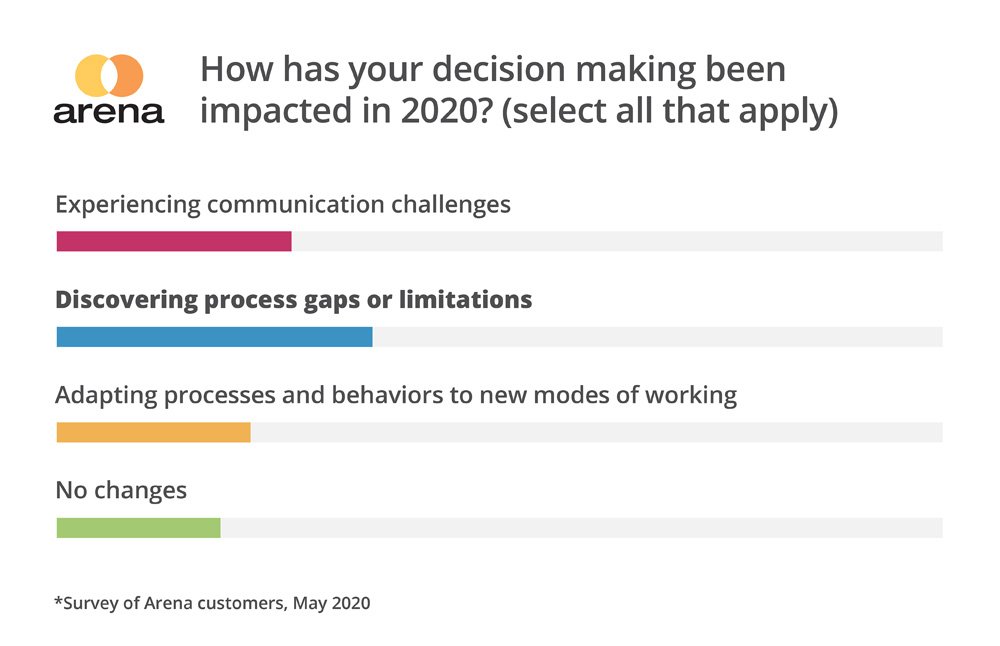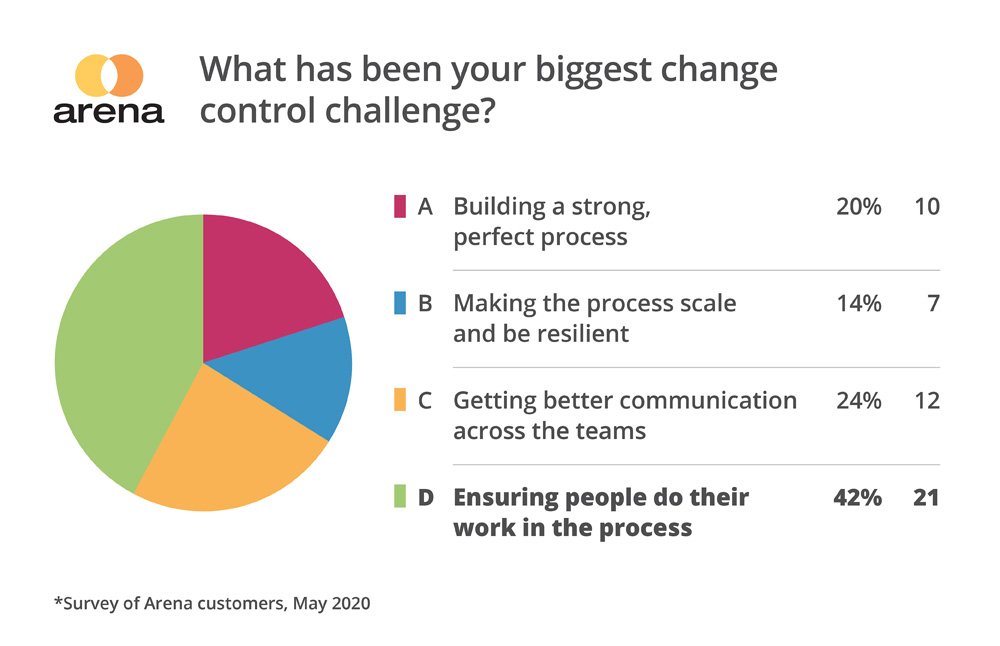4 Tactics for Better Product Decisions
 At a recent online event, product teams shared that 2020 has affected their decision-making and change control processes, with 35% reporting they have discovered gaps in processes and 26% experiencing communication challenges.
At a recent online event, product teams shared that 2020 has affected their decision-making and change control processes, with 35% reporting they have discovered gaps in processes and 26% experiencing communication challenges.
We’ve navigated something historic this year: the largest worldwide workforce transition, from predominantly office-based to virtual, almost overnight. Companies are learning in a “make it or break it” mode. To make it, businesses will need to be willing to challenge assumptions and the status quo.
This rapid transition in work placed a spotlight on our processes. In “normal” times, we can hide the high costs of outdated, broken change control practices through heroic efforts of individuals and band-aid patches to get changes through, parts ordered, and products out the door. Today is not “normal” and we cannot work the way we did in 2019. We are beyond band-aid fixes. We cannot do what we’ve always done.
The good news? Challenges create opportunities. Arena customers are in a better place than many companies as they have the power of a cloud platform they can use to quickly support change process improvements across their teams. However, technology is only as good as your use of it. Even Arena customers found gaps and weaknesses in decision-making workflows when everyone went home to work.

Seize the Opportunity With 4 Tactics
I talk to our customers as often as I can. Unsurprisingly, I’ve asked them lately how work is going, how it has changed this year, what they have learned, or what new projects have risen in priority. We had a great panel discussion recently where our customers talked about whether virtual change control boards could be better than F2F. Here is what I learned in listening to them.
1. Get emotional buy-in.
In a recent survey asking product team leaders and members what their biggest change control challenge has been, 42% said ensuring people do their work in the process was their biggest change control challenge. A culture of trust and inclusion is critical to making plans work and having that flexibility to adjust when needed.
“The most important step when implementing a process … is the sell.” – Tony Bairos, Insulet
Take the time to talk to everyone openly about processes (and any systems you have or are putting in place). Listen to team concerns, struggles, goals, and even fears. When you create a plan and begin to deliver on it, people can see the connections to their work. This builds trust, which is essential for participation in and ownership of processes.
2. Create an incremental plan.
Looking at our survey again, 20% said building a strong, perfect process has been their biggest challenge. I understand the answer. The prevailing mantra in the business, from our university days to industry experts and solution vendors, is “best practice.” But when we try to reach the perfect, we learn that trying to solve for the best most often results in failure.
“You don’t know what you don’t know, but you also can’t wait to know it all.” – Christine Pompa, eMagin
The better approach is to create an incremental plan with a long-term vision, grounded by prioritized needs. Follow the 14% in the survey that chose ensuring the process could scale and be resilient as the biggest challenge.
3. Make processes self-improving.
You can have good change control practices. Many companies do. Once we implement a process—have it functioning fully—we often reach a state of equilibrium. The problem with equilibrium is the process becomes stuck, with no continuous improvement. We fix the original pains and move on to other noisy needs.
In the survey, 24% identified getting better communication across teams as a top change control challenge. Product work is inherently complex with changes varying widely in scope. One way to avoid process stagnation is to design processes to help improve themselves.
- Increase visibility: Visibility brings improvements and supports that culture of trust. Consider including all teams, at least as observers or through release notifications, on change processes, even if they are not usually impacted. People can always opt-out or ignore changes that do not apply.
- Have feedback loops: Make sure people know how to provide feedback about processes. Remind teams of how they provide input on what is working and what is not. If your process is controlled in a system, ideally you have in-context options to collect feedback.
- Practice accountability: Define responsibilities and goals for your change processes. What gets make visible and measured gets done. If you have a system where you can report on change control metrics and even highlight bottlenecks in steps, this transparency helps keep everyone on track and speak up if there are issues with the process (or the product) that need correcting.
4. Keep driving to the plan—and adjust.
One of the interesting by-products of the workforce disruption this year is many companies and teams have some time. Use this time for self-reflection and assessment. Did your team have an incremental plan you’ve abandoned after reaching the first steps? Did you lose focus and need to restart? Striving for Six Sigma, “best,” or other end goals is a good thing—as long as we progress toward these final objectives incrementally. The key here is to progress. Don’t waste the emotional buy-in and culture of trust you’ve gained by stopping halfway through your plan. And, critically, don’t ignore when outside forces (market shifts, product innovations, global pandemics) require the team to update the plan.

Extensive Collaboration
Product development requires extensive collaboration and hard work. From idea generation to sunsetting, the design, creation, launch, maintenance, and planned obsolescence of one product can involve multiple teams, various stakeholders, a network of partners and suppliers, and thousands of hours of work. Economic and political disruptions, unanticipated industry shifts, and now a move to remote work can all pose threats to your product timeline. Use these tactics to either start or get back on track with your team decision-making.
For even more ideas,
Read our practical guide for getting to milestones in a virtual world.
Listen to Arena customers: Industry Experts Talk Virtual Change Control Practices.


